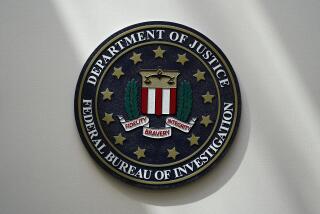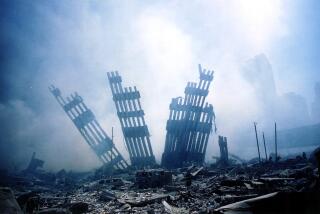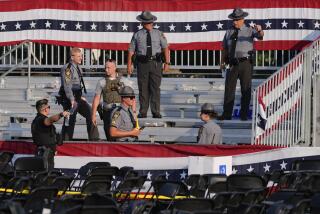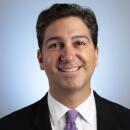Obama’s gamble
- Share via
WASHINGTON — The nail-biting moment, the period when absolute disaster loomed, came at the very start.
About two dozen Navy SEALs and other U.S. commandos were supposed to rope down into a Pakistani residential compound from a pair of specially modified Black Hawk helicopters in the predawn hours Monday, race into two buildings, and capture or kill Osama bin Laden. One chopper stalled as it hovered between the compound’s high walls, unable to sustain its lift, and thudded into the dirt.
Half a world away in the White House Situation Room, the president and his war council crowded around a table covered with briefing papers and keyboards and watched nervously as video feeds streamed in. The special forces team needed a rescue chopper. Gunfire was blazing around them. No one wanted another “Black Hawk Down” debacle.
“A lot of people were holding their breath,” recalled John Brennan, the president’s counter-terrorism advisor.
The extraordinary drama surrounding the killing of Bin Laden encompassed the White House, the CIA and other arms of America’s vast national security apparatus. The tale is part detective story, part spy thriller. But the decade-old manhunt for the Al Qaeda leader ultimately came down to a three-story building on a dirt road in the Pakistani army town of Abbottabad, north of Islamabad.
If the raid went wrong, President Obama would bear the blame. He had vetoed a plan to obliterate the compound with an airstrike. Obama wanted to be certain he had Bin Laden, and there was no guarantee that a smoking crater would yield proof. He had asked for a bolder plan, one that would allow the U.S. to take custody of Bin Laden or his body. It posed far more risk.
As reports flowed into the White House, the commando team methodically swept through the compound. Bin Laden and his family lived on the second and third floors of the largest structure, U.S. intelligence indicated. Officials said that when the commandos found him there, he was armed and “resisted.” They shot him in the head and chest.
There were conflicting reports Monday about whether Bin Laden had fired at the Americans, or whether he had tried to use a woman as a human shield. His wife, who called out Bin Laden’s name during the fight, was wounded in the leg during the battle and may have tried to interpose herself between the troops and her husband, but Bin Laden was not hiding behind her, a senior U.S. official said.
Within 20 minutes, the fighting had ended. In 20 more, the military had flown in a backup helicopter. The commandos questioned several people in the compound to confirm Bin Laden’s identity, detonated explosives to destroy the crippled Black Hawk and then departed. As they flew off, they carried with them the bloodied corpse of the tall man with a thick beard.
In addition, the raiding party took “a large volume of information” from the compound, a U.S. official said, “so large that the CIA is standing up a task force” to examine it for clues. The material, which includes digital and paper files, could be a treasure trove of new intelligence about Al Qaeda, the official said. Among other things, officials hope the information will lead them to Al Qaeda’s other leaders.
They left behind the bodies of four other people killed in the raid -- a courier they had been tracking for years, his brother, one of Bin Laden’s sons and an unidentified woman.
The Pakistani government, which had not been informed of the raid in advance, scrambled aircraft in response to the firefight, but the low-flying U.S. helicopters quickly flew out of Pakistani airspace.
Within hours, Bin Laden’s remains had been given funeral rites designed by the military to be consistent with Muslim practices and dropped into the northern Arabian Sea from the hangar deck of the aircraft carrier Carl Vinson. The FBI quickly slapped “Deceased” on its Internet posters for the world’s most wanted terrorist.
Bin Laden had vanished after the Sept. 11 attacks of 2001. U.S. military commanders had failed to close the noose around his Afghan stronghold in Tora Bora, and the Al Qaeda leader and his aides somehow hiked across the rugged border region into Pakistan.
Once or twice a year, Bin Laden popped up on a new video or audio recording, mocking America’s leaders and urging his faithful to follow his path. They did so with bombings in London, Madrid, Bali and elsewhere.
The CIA knew that Bin Laden had stopped using cellphones and other electronic or digital communications long ago to evade U.S. intelligence. He relied on human couriers instead to get his videos and other messages out to underlings and followers.
Find the courier, the thinking went, and they’d ultimately find Bin Laden.
Interrogators at the U.S. naval base at Guantanamo Bay were pushed to ask Al Qaeda suspects in custody about possible couriers. The information came in pieces, a U.S. official said, and it took years.
“One courier in particular had our constant attention,” a U.S. intelligence official said. Detainees “indicated he might be living with and protecting Bin Laden. But for years, we were unable to identify his true name or his location.”
The break came in 2007. Khalid Shaikh Mohammed, the former operations chief for Al Qaeda and self-described mastermind of the Sept. 11 attacks, disclosed the nickname of a Pakistani man he said was Bin Laden’s most trusted confidant and courier. Confirmation came from Abu Faraj Libbi, another captured Al Qaeda leader, and other prisoners.
It took the CIA until last summer to find his fortified compound in Abbottabad, a quiet city in rolling hills north of Islamabad. Named for a British colonial officer, the former hill station is home to a prestigious Pakistani military academy, an army regiment and thousands of retired military officers.
Satellite photos showed the house and 1-acre compound had been built in 2005. The high walls, barbed wire and pervasive security cameras suggested it was designed as a private fortress.
It took months to build a picture of who was living in the compound, but eventually the CIA concluded that one of the families was likely to include Bin Laden, several wives and children.
“There wasn’t perfect visibility on everything inside the compound, but we did have a very good idea” of how many people lived there, how many women and children were in one of the families, and other pertinent details, said one of the intelligence officials.
With help from the National Security Agency, which intercepts communications, and the National Geospatial-Intelligence Agency, which provides detailed maps and other data, the intelligence finally coalesced in February.
“Our confidence level grew much higher” that Bin Laden might be hiding in the compound, a senior official said. But the intelligence wasn’t definitive.
As the details accumulated, Obama ordered his national security team to develop courses of action, according to senior administration officials.
The team brought several proposals for attacking the site, and they were refined over the next few weeks.
“There was a body of intelligence brought” to Obama, a Pentagon official said, “but in the weeks and months beforehand, his personal attention pushed the case to a new level.”
As officials refined their plans, the SEALs team practiced the raid in early April, using a replica of the compound. Officials said they hadn’t decided in advance to kill Bin Laden rather than take him prisoner.
“There were certainly capture contingencies,” said a senior Pentagon official. But until nearly the last minute, it wasn’t clear the mission would go.
Obama met with his senior national security aides on Thursday to review three options: the commando raid, an airstrike, or a pause for further intelligence gathering. He went around the table of advisors and asked each to weigh in.
The intelligence remained uncertain about whether Bin Laden was actually at the compound. Half of those present supported the raid; the rest were divided between the other two choices, a senior official said. Obama then left the meeting without announcing his decision.
Friday morning, just before Obama flew to Alabama to survey the devastation left by a flurry of tornadoes, the team met again in the White House Diplomatic Room. “It’s a go,” the president said. The UH-60 Black Hawks were supposed to fly on Saturday, but because of bad weather, the commanders pushed the schedule back a day.
Had the operation gone that day as planned, it would have coincided closely with a North Atlantic Treaty Organization airstrike on a villa in Tripoli where Libyan leader Moammar Kadafi, another longtime U.S. foe, apparently had visited. He escaped harm, but the missiles apparently killed one of his sons and three grandchildren.
Saturday evening, the president grinned broadly and offered light remarks at the annual White House correspondents dinner at a hotel in Washington. He joked about releasing his birth certificate and poked fun at Donald Trump.
Comedian Seth Meyers quipped that Bin Laden was hiding in plain sight by hosting a C-SPAN show. The president had in fact spent much of the day being briefed on the operation.
On Sunday, Obama monitored the final preparations in the Situation Room, along with Tom Donilon, his national security advisor. Others quickly gathered, including Vice President Joe Biden, Secretary of State Hillary Rodham Clinton, Defense Secretary Robert M. Gates, Joint Chiefs Chairman Adm. Michael G. Mullen and James R. Clapper, director of national intelligence.
The president joined the group as the operation got underway around 2 p.m. Sunday Washington time -- around midnight in Pakistan. The room was silent in between reports.
“It was probably one of the most anxiety-filled periods of time, I think, in the lives of the people who were assembled here yesterday,” said Brennan, the president’s Arabic-speaking counter-terrorism advisor. “The minutes passed like days.”
At 3:50 p.m. Sunday, Obama was told that Bin Laden had been “tentatively” identified. A few hours later, he was told that there was a “high probability” that the Al Qaeda leader had been killed.
DNA tests, using samples from several Bin Laden family members, would later confirm Bin Laden’s identity.
The risk had paid off.
Brennan said Obama’s reaction to the news was simple: “We got him.”
--
Times staff contributors
Contributing to the coverage of Osama Bin Laden’s death from the Washington and New York
bureaus were Neela Banerjee, Geraldine Baum, Brian Bennett, David S. Cloud, Ken Dilanian,
Bob Drogin, Kim Geiger, Matea Gold, Tom Hamburger, Kathleen Hennessey, Lisa Mascaro,
Melanie Mason, Michael A. Memoli, Peter Nicholas, James Oliphant, Christi Parsons, Paul
Richter, Richard A. Serrano, Richard Simon, Katherine Skiba and Tina Susman.
More to Read
Sign up for Essential California
The most important California stories and recommendations in your inbox every morning.
You may occasionally receive promotional content from the Los Angeles Times.











